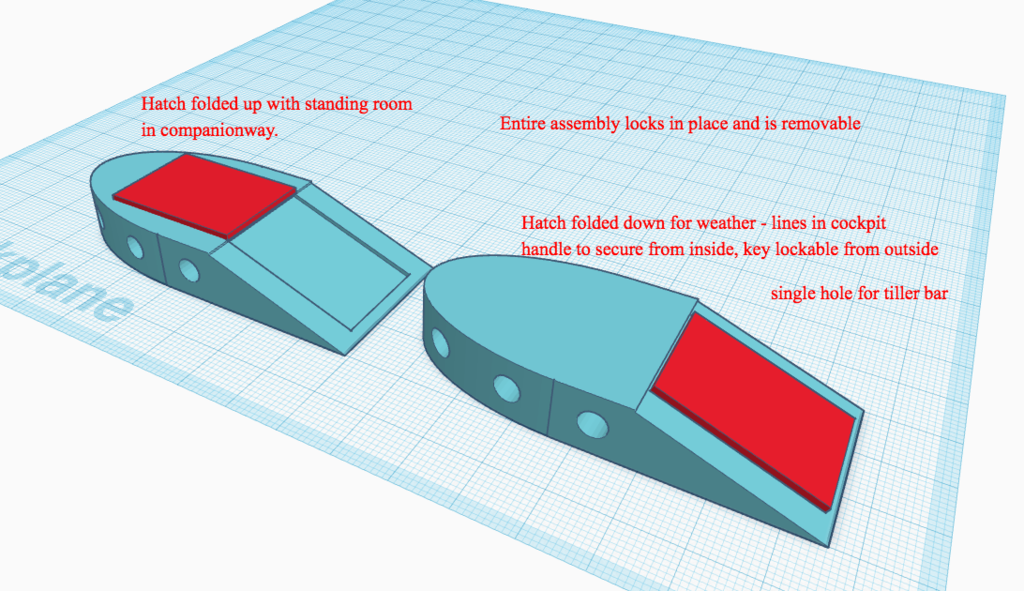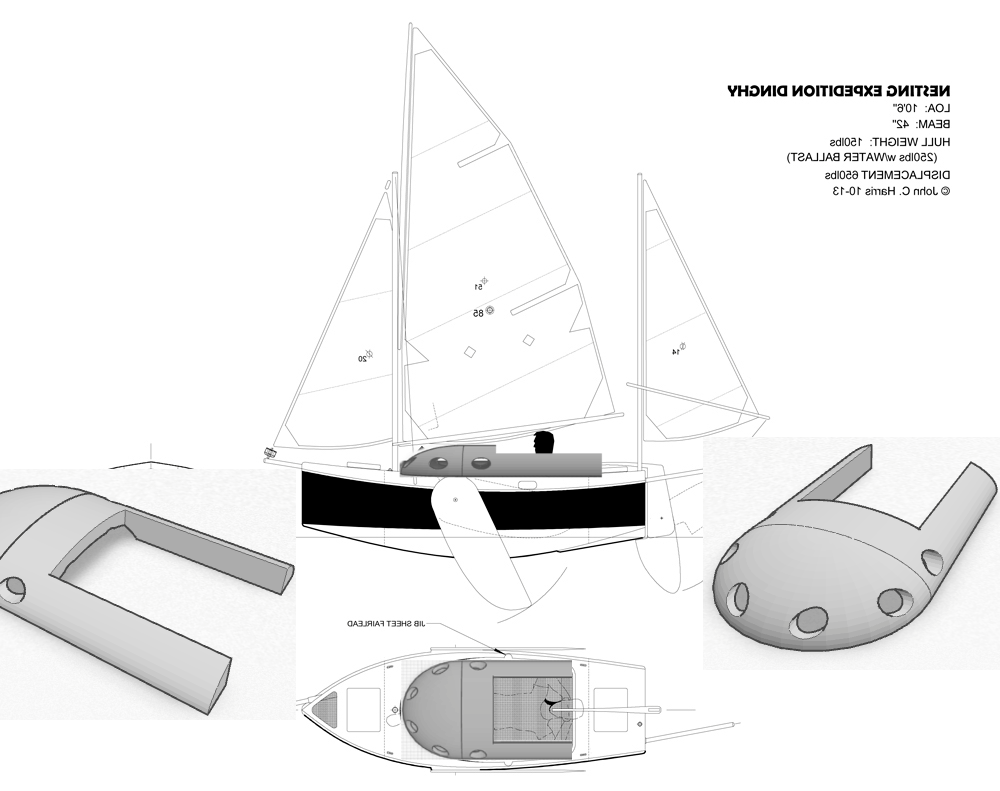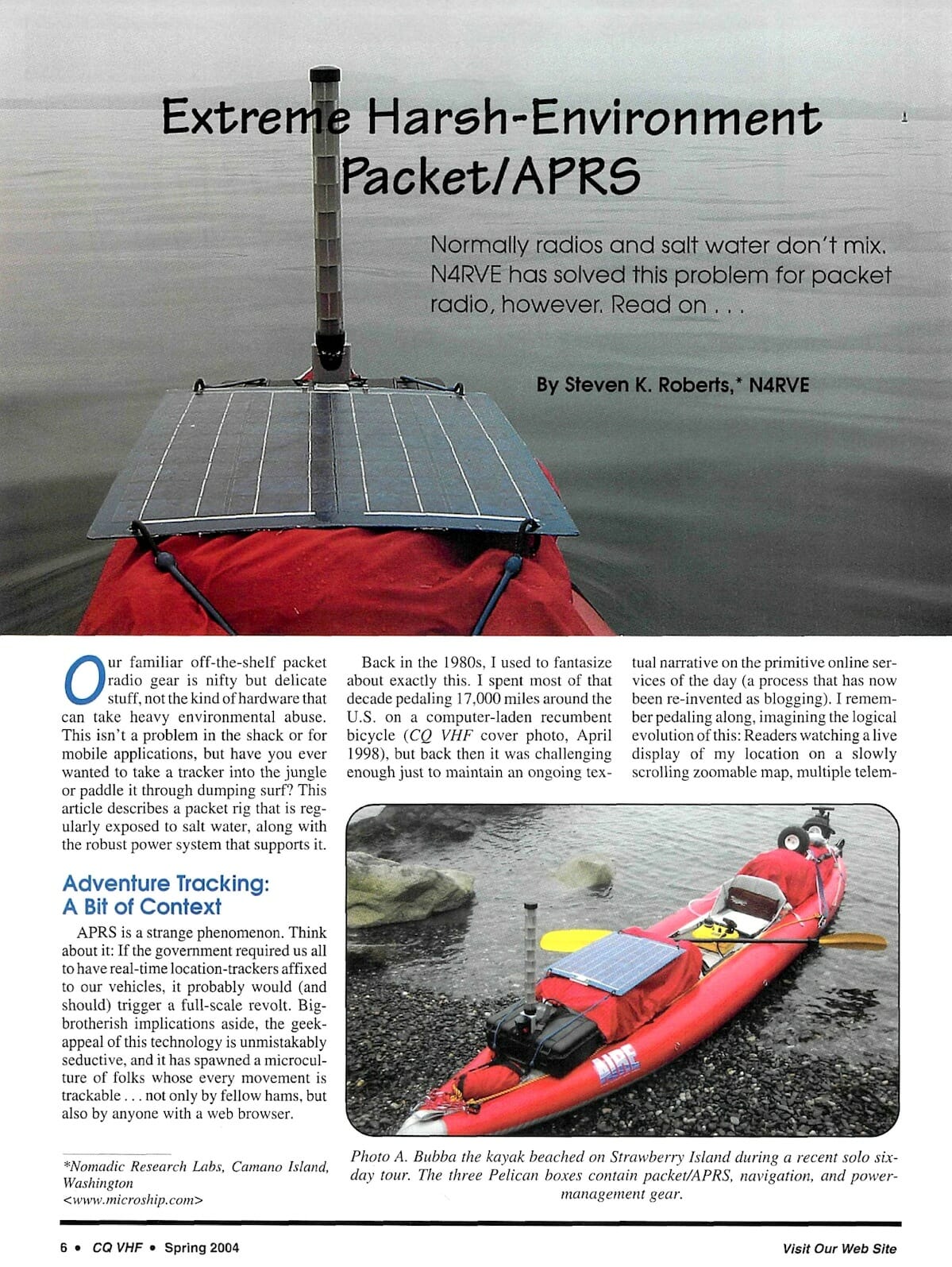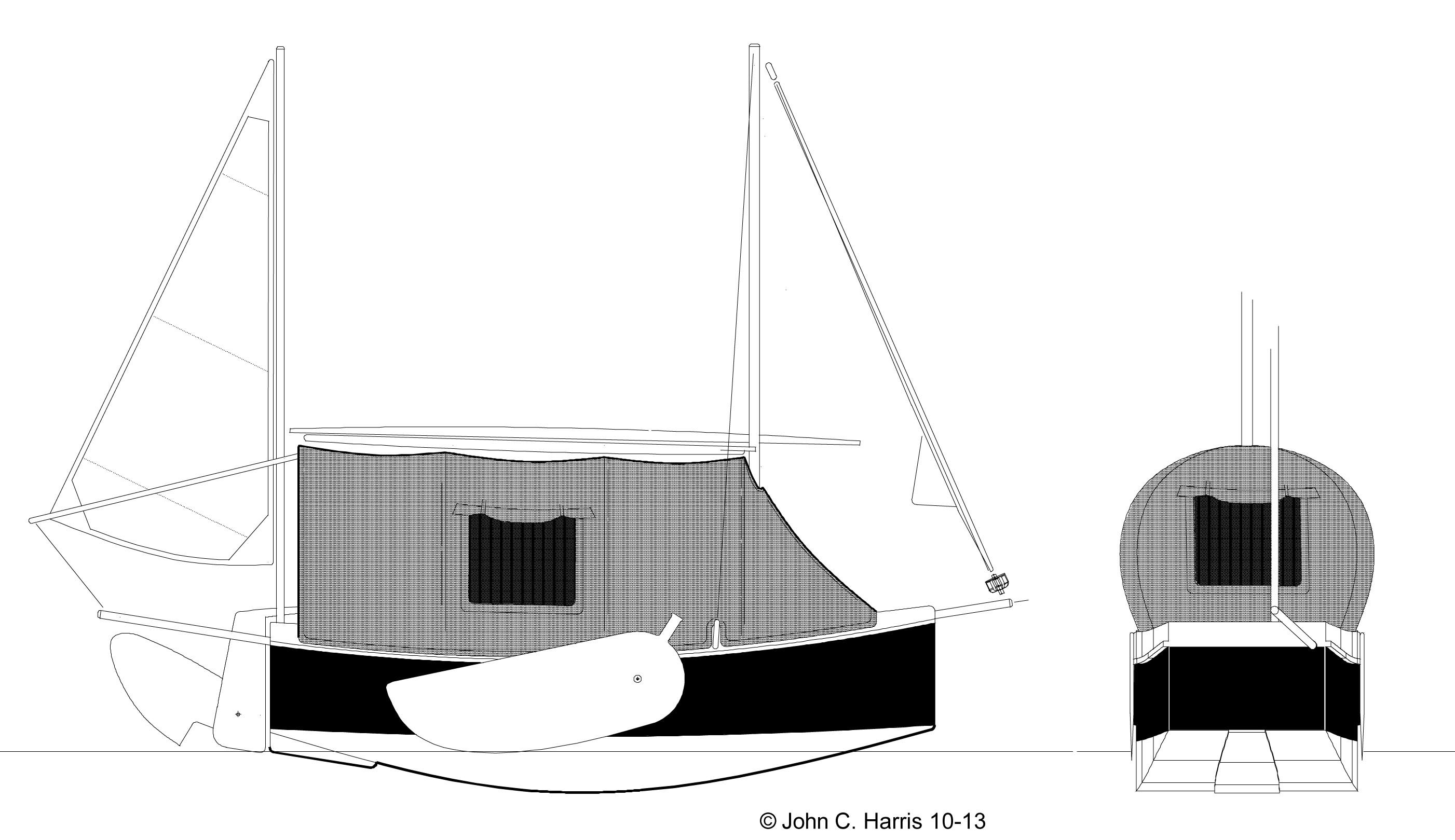Builders' Forum |
|
| ↓ Scroll to Last Comment ↓ | Forum Guidelines | Builders' Forum | |
Nesting Expedition Dinghy Ideas and Questions
I must say that I am very excited by the idea of the Nesting Expedition Dinghy (NED).
I have been thinking about a cruising dinghy like this for a while, since reading parts of “3 years in a 12 foot boat” by Stephan Ladd, “Paddling North” by Audrey Sutherland and “The Happy Isles of Oceana” by Theroux. I have yet to read about the exploits of Frank Dye, but its on my list as well as a few others.
While my literary armchair traveling shoots for one extreme as an inspired idea, any actual plans tend to go the other other moderate less adventurous end of the spectrum, but I still think about having a boat that is vastly more capable than I am as a sailor. Up to this point, I have done day tripping in SOT and Inflatable Kayaks in protected estuaries, bays and the kelp beds near the Santa Cruz Wharf. My other favorite put-in is the fairly new ramp and launch area in Alviso (bottom of the San Francisco Bay). I just got a Kayak Sailor rig to clip to the yaks. There are a couple of places to Kayak Camp in the area, such as Angel Island in the bay near Sausalito, but with most places being restrictive of camping, it is becoming apparent that I will have to be able to anchor on the water if I ever want to do anything more than day trips.
The NED appeals to me as I do have limited storage (and strict rules about what and where). Storage costs have gone up with the rents in the SF Bay area, so I am definitely interested in something that goes in a shed or on top of my camper, as a backup to a small trailer that can be stowed out of the way when not in use. I may have difficulties with building space as well, but LOA is more of a problem for my existing space.
I am a complete neophyte to stitch and glue as well as anything but the most basic sailing, and have never built anything, so please excuse me if I am asking stupid questions, etc.
- First Question: what does anyone think of my ideas? Feel free to inject me with reality.
Security Concepts
- Locks on the storage hatches
- A locking “tonneau” type cover over the cockpit to provide secure storage (with the boat nested or not) while docked, or when the boat is sitting on the trailer. This could be raised up a bit like the cockpit cover and “companionway” on Matt Leyden’s Paradox, for example, as an alternative to a tent. If one were caught in nasty conditions, perhaps one could heave to, and then place the hard cover over the cockpit and wait out the nasty conditions.
- Dodgers that would work while underway
- A good tent design for camping
- Locking the boat to the trailer or dock with a cable running through the oarlock?
Electronics (Technomadic substrate)
- Seal off items like batteries and a network routers in the stern storage area with a solar panel on top. run a long distance wifi antenna through the mizzen mast, with possibly a cell amp.
- A basic raspberry pi server/NAS in the sealed compartment
- A water proofed tablet in the cockpit mounted on the bow side (charts, weather, communications, writing while under way, etc.)
Cockpit items
- I like the galley box concept: http://www.clcboats.com/life-of-boats-blog/build-a-small-boat-galley-box.html
- Porta potty?
- Handheld Marine Radio (a lot of stuff is just coming out of the Kayak kit)
- Bilge pump for emptying the cockpit. A separate system for the ballast if fresh water can be used.
Other Questions:
- The approximate hull weight is given. What would it be per piece?
- Could the water ballast realistically be used for fresh water storage?
- 2 HP motor mount? (I know, I KNOW, but it might be nice to have the option)
- Is there any reason why chine runners of the Matt Leyden Paradox type wouldn’t work on this boat? If they would work, one wouldn’t need the lee boards in all conditions.
I’m sure that I will think of a bunch of other things, but these are the first ideas/questions that come up this early in the research phase.
Cheers,
John
19 replies:
RE: Nesting Expedition Dinghy Ideas and Questions
John,
I second Lazlo on the electronics. It's not just the moisture that destroys electronics, its corrosion from the salt (and a Raspberry Pi 3 definitly needs good air circulation). I carry a very inexpensive tablet with GPS and navigation software and charts, however I never assume it will not fail. Electronics on boats always do. I have a compass, dividers, and parallel rules --- and paper charts in a "waterproof" container. I also have a solar battery charger.
Lazlo is very correct about all the negatives using ballast tanks for potable water. Bad water has ruined more than a few expeditions. Sealable, washable, plastic water containers are light and come in a myriad of sizes and shapes.
Cheers,
Dick
RE: Nesting Expedition Dinghy Ideas and Questions
What a lovely Christmas present - to check and see these two excellent responses - thank you both!
I was not aware of the Wag Bag system - I like the looks of that - I may replace the porta potty in my camper now!
I suspected as much about fresh water ballast. Stephen Ladd did such a system on his Sea Pearl, and I never looked into the details too carefully, but he crashed the boat on a reef before he got a chance to get sick.
Definitely going to have a toolkit and fire extinguisher, and back up for any electronic navigation.
As for electronics, I am aware that it is difficult but possible. One of my friends is Steve Roberts of Technomad fame for bikes and boats, and he actually spent a fair amount of effort in solving those problems satisfactorily for his Microship and even his inflatable kayak:
http://microship.com/extreme-harsh-environment-packet-aprs-in-kayak-cq-vhf/
The initial solution is a completely sealed case like a pelican, and then outgassing strips so that any flow of moisture or gas is outward. The other is completely sealed connectors. Anyway, I am aware of the likelihood of failure in this realm, but I'm too much of a geek technomad wannabe to give up entirely.
Any thoughts about dodgers or cockpit covers?
RE: Nesting Expedition Dinghy Ideas and Questions
This was one thought I had while noodling on tinker cad - not to scale or correct dimensions of any kind. This is something that could be removed or put on. The advantages over the tent is that it could provde shelter while under way or in an emergency heave to or jib sailing in a storm. The bigger advantage is more (lockable) security for the cockpit.

RE: Nesting Expedition Dinghy Ideas and Questions
John,
From what materials would you be building this removable cabin top? Too heavy and it will hurt stability and too light and it will be fragile and not too secure. I never locked my ragtop Triumph TR4A. That would have been an invitation to any thief with a pocket knife. If I needed to lock something up, I put it in the glove box.
Cheers,
Dick
RE: Nesting Expedition Dinghy Ideas and Questions
I hadn't decided specifics or even if this type of cover is doable. With the weight consideration, I was thinking about a surfboard type of construction - fiberglass on some sort of styrofoam, with something stronger just for things like the base and/or hatch frame. I could use a premade locking hatch (usually plastic) If I could find one of the right configuration.
Alternately, perhaps I should just focus on a cuddy cabin type dodger of tent material.
RE: Nesting Expedition Dinghy Ideas and Questions
Even if I don't make a hard cockpit cover for sailing, I may make a hard cover for the cockpit for when it is on the trailer, so that the boat can double as a storage trailer when not in use.
RE: Nesting Expedition Dinghy Ideas and Questions
Here is my second concept - simplified and I may simplify it more. Not to scale or proper dimension, curves, etc. There is no attempt to make this lockable. It is basically just a dodger, but which can add a small tarp or tent if caught in rain while underway. I may axe the back section altogether and just have a hard dodger to which a tarp can be attached. 
RE: Nesting Expedition Dinghy Ideas and Questions
John,
At my house we have a similar cover at the top of the pull-down folding attic stairs. It's made of plastic foam and does a good job of keeping the cold air in the attic from creeping into the living area. Perhaps you could carve it out of styrofoam and coat it with epoxy resin and a little paint for strength and durability. It would still be light.
Cheers,
Dick
RE: Nesting Expedition Dinghy Ideas and Questions
Dick, that is exactly the approach I was thinking of (I said surfboard, but I realize that surboards are actually heavier).
But I am getting ahead of myself. I have to think about building the boat first, and for that I will need more info than is in the study plans, owing to the fact that I have never built anything of this sort, and I will need the "for dummies" version, if not a full kit.
There was some talk about making plans downloadable and an instructional wiki. There cannot be too much detail for me at this point.
RE: Nesting Expedition Dinghy Ideas and Questions
As for the non-recommended electronics: As indicated, a friend has been somewhat of a technomadic pioneer in this realm, doing insane things:
https://microship.com/extreme-harsh-environment-packet-aprs-in-kayak-cq-vhf/
Since that was done, OEMs have gotten in the business of outfitting kayakers for their devices. The outgassing vapor-phase corrosion inhibitor strips will be one useful addition from above, but otherwise, everything can be obtained off-the-shelf.
https://www.voltaicsystems.com/nanuk-904
Now solar panels made for kayaking connect to waterproof cases also made for kayaking without endangering the integrity of the case. A cheap (as possible) android tablet with wifi and built in GPS will live in a separate waterproof case that allows it to be operable. In the right configuration, the charging station will charge a phone, camera, tablet or laptop.
The goals of electronics are first for navigation and weather information, secondly for writing, photography and remote communications. I have yet to refine what will live where and how much. A lot of this will only be used when docked at a harbor/campground, and then securely stowed and charging while underway.
RE: Nesting Expedition Dinghy Ideas and Questions
John,
I just re-read this thread and I cannot help but wonder about the need for complex electronics. You say that your a techno-geek. I've been a professional software developer since 1972 (yes, over 44 years at it) and am currently a senior systems architect with an international software vendor. One of the reasons I go out on the water is to get a break from technology.
I love GPS and the navigation and weather software it makes possible (simple tablet in a waterproof case) and I really appreciate the ability to communicate using a mobile phone and hand-held VHF (waterproof cases). I also carry a solar battery charger to top off my devices (not enough for 24x7 device use). My mobile phone acts a a wireless hotspot for the tablet when I need it.
I've been on the saltwater since I was a child and I'm 70 years old. I've been out in gales and one hurricane, I've become a firm believer in Murphy's Law and the KISS principle. (I have 3 Raspberry Pi's and cannot imagine taking them to sea, because I worked hard to ventilate, not seal, them.) Please ask yourself why one would want to add complexity to the joys of sailing.
Cheers,
Dick
RE: Nesting Expedition Dinghy Ideas and Questions
Hi Dick,
In principle, I agree with you, and my minimal system is a waterproof tablet with the waterproof solar charging system listed above. My first job requires me to be able to login and solve problems at least once every couple of days, so I have to be able to do that if I ever want to do a trip that is two weeks or so. I don't need a pi for that, just reliable power and connectivity. My iPad had a cell connection, and most of the harbors in my area have wifi.
My second job is writing, and I plan to do at least an hour in the evening at docks and anchorages. The things I need for that can be safely stowed in the waterproof case until I am anchored. I also want to get a fair amount of photos and video.
I really don't need a pi, except testing the limits of geekery in extreme conditions which is fun for me, but I'm surprised that you think it isn't feasible, since there are many projects out there with a pi in a waterproof case. I question how much airflow is necessary.

RE: Nesting Expedition Dinghy Ideas and Questions
It seems that most of what you want from your electronics already exists in a depthfinder with gps. Get a good dry box for a water resistant smart phone with a couple extra battery packs for use when your not under way
RE: Nesting Expedition Dinghy Ideas and Questions
Was wondering if a cocpit tent would be available as an option? Might be something for john to consider, maybe hook up with someone to make custom tents for clc boats , might be a lucrative accessory line. I can think of several boats that that would work for
RE: Nesting Expedition Dinghy Ideas and Questions
John,
I completely understand your need to connect for customer issues --- that's been part of my life for over 40 years. I guess I'm just cautioning you to avoid complexity where it's not absolutely necessary. For me, every minute on the water is precious and helps me recharge my own batteries. I'm not a kayaker and don't know much about the sport. My greatest joy is sailing and I've singlehanded between Narragansett Bay and Casco Bay a few times over my lifetime. When I saw the picture of the kayak in the article you included in your post, I was appalled by what looks like clutter to me. I guess to each his own, but in my world, in sailing and in software, clutter increases the potential points of failure --- so I try very hard to avoid it.
Best wishes and best of luck to you.
Cheers,
Dick
RE: Nesting Expedition Dinghy Ideas and Questions
John,
When we discussed potable water in ballast tanks earlier in the thread, I mentioned containers for potable water. Here's a product, Smart Bottle, which can be used for the purpose and will fit in many different places on a boat.
Cheers,
Dick














RE: Nesting Expedition Dinghy Ideas and Questions
» Submitted by Laszlo - Sun, 12/25/16 » 8:06 AM
Merry Cristmas, John!
All my expeditions (what few there have been so far) have been done in the Faering Cruiser, not a NED, but I can give you a few bits of advice (worth triple what you're paying me) based on that.
First, lose the electronics except for a floating waterproof handheld VHF 2-way radio. In such a small boat water's going to eventually get in everywhere. If you do manage to make a completely water-tight compartment, then even with a Raspberry Pi you're going to have heat-retention issues (I've got almost 2 dozen of them, models 0 through 3, and one of my projects involves monitoring the CPU temperatures). If you must have electronics, keep in mind that you'll be in a very humid atmosphere and condensation will be almost as big a problem as immersion. Shock and vibration will also argue for solid stae storage devices instead of rotating ones. Electrolysis and corrosion will also be enemies in a salt air/water environment.
Even with the much larger cabin and cockpit space of the FC, I've found a WAG bag to be more useful than a porta-potty. I suspect it would be even more pronounced in the much smaller NED. They're also easier to legally dispose of than the contents of a chemical toilet.
A bilge pump is a great idea. Definitely a manual one, maybe also an electric. The thing to watch out for is that the NED's cockpit is a big bath tub that can hold a lot of water. An electrical pump system would have to handle being completely submerged. This includes the entire electrical system, not just the pump. And as John has shown us, the NED can get knocked down. Even though it stayed high and didn't take on much water then, an unfriendly motorboat wake or unlucky breaking wave at just the wrong time could change that.
For draining the ballast tanks on the FC, I leave the water in until after the boat is on the trailer, then use a garden hose to siphon it out. Much easier than a hand-operated bilge pump, much simpler than an electrical system and totally immune to total immersion. I'd suggest the same for you with a manual pump for the rare time when you must get the ballast out before putting the boat onto the trailer.
Speaking of the ballast tanks, based om my experience with the FC, there is no way I'd use the ballast tanks for potable or even washing water. There's no easy way to clean them to human comsumption standards and warm fresh water is a breeding ground for Naegleria fowleri, the brain-eating amoeba. Ballast is ballast and I'm going to leave it that way.
Another reason not to use the ballast tanks for fresh water is what would you use for ballast if you drink it all? John blamed the photo sequence above on empty ballast tanks.
That's what I've got for you. Oh yeah, bring a fire extinguisher and a small repair toolset.
Have fun,
Laszlo